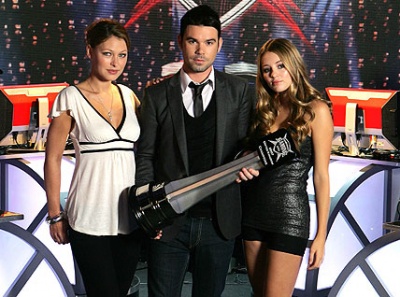Championship Gaming Series
(add link) |
|||
| Line 5: | Line 5: | ||
== Host == | == Host == | ||
| - | [[Dave Berry]] and Emma Griffiths | + | [[Dave Berry]] and [[Emma Willis|Emma Griffiths]] |
== Co-hosts == | == Co-hosts == | ||
Revision as of 16:34, 27 April 2020
Contents |
Host
Co-hosts
Commentators: Paul "ReDeYe" Chaloner and James "Too Good" Harding
Hostess: Keeley Hazell
Broadcast
Steadfast Television for Sky One, 24 December 2007
Synopsis
Coverage of the UK "esports" championships to find the best computer gamers in the country to take on the rest of the world. Disciplines inclide Counter-Strike:Source, Dead or Alive 4, FIFA 2007 and Project Gotham Racing 3. The UK championships, between the London Mint and the Birmingham Salvo, are decided before worldwide matchups are played out. The finallists go to LA to play for a $5m prize pool.
Despite this programme being first and foremost a television production, rather than coverage of an existing eSports championship, co-produced by a number of networks internationally (Sky in the UK, DirectTV in the US amongst others) acting through a central Championship Gaming Series consortium, it is unique in that its competitors were salaried eSportspeople, in a system not dissimilar to the 'franchises' of American professional sports, and as such the Birmingham Salvo spent a while touring the British eSports scene, for what it is, in between CGS tournaments.
The league folded entirely shortly after the second World Final (which Birmingham won, making them champions forever- you don't hear anyone talk about that when we inevitably crash out of the football world cup in the quarter finals), citing the difficult economic climate- the second tournament took place at the beginning of the recession- although, in the UK at least, being hidden in a late-night time slot as well as a selective approach to the episodes shown and an alleged refusal to sell unaired episodes to the eSports-centric videogames channel xLeague TV which was also running at the time probably didn't help.
Some attention should be given to the competition's... "original" structure. Rather than individual diciplines being their own tournaments (as in sporting events like The Olympics) or expecting competitors to be multi-diciplinary (as in gameshows like The Krypton Factor), each team of ten would compete in their own dicipline alone, and progress to later stages or be eliminated as a team, in an otherwise standard knockout tournament.
Rather than success or failure hanging on a number of events won, each of the five events would be worth a different number of points, depending on each team's performance.
In the racing game (the aforementioned PGR3 one year, Forza Motorsport the other), the two players from each team would race, with the winner taking home four points for their team, the second place two, third one and nothing for coming last. This is the sole event that makes sense.
In FIFA, a point is awarded for each goal- so a no score draw is worth nothing to anybody, a 3-0 win is worth three points to one team and nothing to the other, and 2-1 is worth two to one and one to the other.
The two Dead Or Alive events (one male, one female) were 'best-of-nine', with one point awarded for each win, and the event stopping when one player gets five KOs, so take-home scores could be anything from 5-0 to 5-4.
The five-man team CounterStrike event was similar, comprised of eighteen rounds, played in two halves with an optional 'sudden death' tiebreaker round, rather than being a best of 19.
This means that a team could come first and second in The Racing (putting them 6-1 up), get two shutouts in DoA (16-1) and win FIFA by two clear goals (18-1) and then still be eliminated if the other team wins every CS match.
Following the league's closure many competitors have remained in the eSports scene, such as Birmingham Forza competitor 'daveyskills' taking the UK's only gold in the 2010 World Cyber Games.
Decent set design and good crowd atmosphere punch this above most other attempts to cover computer games in the past. Sufficiently animated overlays help the viewer keep track of the action, and the TV graphics are flashy enough to compete with the graphics of the games themselves. It's just a shame that the uneven scoring and unimaginative casting - i.e. MTV numbskulls and Page 3 stunna Keeley - detract from what is otherwise a well-assembled package.



